December 12 - 15, 2000
PalmSource 2000 Report
Palm's big developer show is under way
in Santa Clara, and I thought I'd post a running list of what's going on at the
show for interested Palm watchers.
Tuesday, December 12
The show started with a Keynote by Palm's CEO Carl Yankowski, in which he mentioned
that upcoming Palm units, in a variety of configurations, will be able to
access the Internet on quite a range of wireless networks, including
Mobitex (on which the Palm VII runs), GPRS, CDMA, CDPD, GSM, and PDC.
He announced that Samsung today has become a licensee of the Palm OS,
which they will integrate into a future cell phone, slated for release in the
first half of 2001.
Finally, he announced their vision for the future of Palm products. It starts with
the already announced MyPalm portal, which works with a Palm VII initially, which
helps users sync with Palm's AnyDay.com services. Then they will enter what he
calls their "Communication Phase I, in which Palm will include message notification
instant messaging, and seamless access to Exchange email along with their existing
email solutions. In Phase II, voice will be added, first as a phone, then as a data entry
and access tool, as I understood it. A little vague on this point. Palm OS 4 was mentioned, and it
will apparently facilitate these new voice features.
Security Phase I was next, allowing the Palm to function as a wallet, to get a soda or
make other purchases. OS 4 was shown later, with reference to the security features
that will allow records to be masked a little more efficiently, among other things.
Security Phase II would include more security allowing higher security items like
banking transactions.
Later Bill Maggs, Palm's CTO, showed a couple of cool things, including a large test board
of an upcoming Palm design using a Cirrus Logic ARM chip. It performed quite quickly, yet
he demonstrated compatibility with legacy Palm apps.
Maggs also demoed a Bluetooth link between a Palm V and a cell phone, entering an audience
member's number into the Palm and we were able to watch it appear on the phone immediately.
At first it didn't work, and he uttered a colorful obscenity that made the audience laugh at
his honesty. But the second time it worked fine. Finally they played a game over a bluetooth
connection between two Palms. I have actually seen Bluetooth working on a Palm before, much
earlier in the year, but it was nice to see more than the virtual whiteboard they had back then.
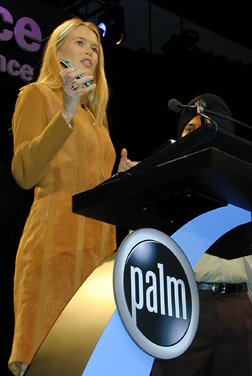
The very likeable Satjiv Chahil, Palm's Director of Marketing, was introduced with a video
of his performance with MTV's Daisy Fuentes at a Wired Magazine awards ceremony. It seems
he had been picking the brain of our Spanish speaking emmcee to get the creative and charming Spanish
words he said to Ms. Fuentes on stage (something like, "Where do you keep your Palm--close to your
heart?" What a charmer; the best part is that it appeared to work). In keeping with that tradition,
he introduced another beautiful
woman today--Claudia Schiffer--and they announced the availability of her new light blue Palm Vx on her
website, claudiaschiffer.com. For the first time in PalmSource
history, photographers rushed the stage, myself included. Honestly, I don't even know what she said.
Later at the Press Luncheon, Yankowski mentioned that they're looking into organic, or LEP (Light Emitting
Polymer) displays for future Palms. Though the technology is not yet ready, it promises to provide
low power consumption and high resolution, inexpensive displays for many products.
They also mentioned that Palm units running on ARM will likely debut in 2002; that audio will likely
only be supported by addition of third-party solutions for the near future; and they mentioned the possibility
of spinning out Palm's hardware division in the distant future when asked about the difficulty of
supporting competitors who are also licensees, like Handspring, Sony, and TRG.
Of interest among the items I saw today in the Exhibit:
Stevens Creek Software -- Now supports Pentax PocketJet 200 with their PalmPrint application. It was apparently
a little more difficult to support this printer, since it's a bitmap-only printer; in other words,
it doesn't have any onboard fonts, so Steven Patt, the programmer and co-owner, had to make the Palm
rasterize the images. The result is very nice output. They're also supporting Bar code scanning on the
Visor, using either the Symbol CSM 150 Springboard Module, or the Momentum Module from PSC.
www.stevenscreek.com
TRG has announced their new BackupPro software, allowing quick, one-tap backup from RAM to a
Compact Flash card. It's available for US$9.95 on their website: www.trgpro.com
Handango, the big handheld portal, announced that they've partnered with Genisar, a developer
of online interactive technology, to enable Handango customers to demo software on the website
without downloading the app at all. Sounds like a cool thing. www.handango.com
Bachmann Software showed me their print software for Palm, which include PrintBoy, PrintBoy Documents,
PrintBoy Deluxe, and Bachmann Print Manager 3.2. PrintBoy can print appointments, addresses, to dos, memos, and email.
PrintBoy Documents can handle printing of anything in the standard Palm .doc format. PrintBoy Deluxe
adds Text Notes and Scribble Notes, enable printing of either text or graphical notes. All of the software
above requires a printer with IrDA capability. www.bachmannsoftware.com

Finally, at the end of the cool stuff list is REALVision Technology's CarpeDiem V, a GSM phone for the
Palm V. This was announced just before Handspring's Visor Phone was officially announced, but the
CarpeDiem V won't be available for European markets until February, and not in the US until mid- to late-2001.
At any rate, it looks cool and seems to work well. www.realvision.com.hk
Wednesday, December 13, 2000
I don't have a whole lot to say about today but the highlight can be summed up in two words:
Jeff Hawkins. He gave a witty presentation to debunk what many analysts have been saying about the
Palm OS. To start with, he put up a quote from an analyst that basically said the the Palm OS is incapable of multimedia, and
certainly not multitasking.
Then he went over to the display table and consulted his Visor. He began to play some rock music on his
SoundsGood MP3 module, then he began to tell us about his recent snowboarding lessons in the Sierras. He
played an ActiveSky video of some snowboarders jumping off a ramp and doing helicopters,
pointing out which one was him as the
music continued to play in the background. It was like a Dew commercial, and it was multimedia, and it was
multitasking for all intents.
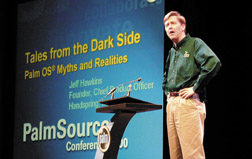
Next he put up a quote that said you can't do communications on a Palm OS device, just not possible. So he
went back to "consult his Visor" on that. He placed a mock call to a prominent competitor and began to talk about it
(a live actor answered and played the part), then he put that guy on hold, called another "competitor" and
conferenced them in together. They began to argue, and he put them on hold, switched to the SMS program and
sent a short message to Carl Yankowski of Palm, demonstrating that not only is communication possible,
but multitasking as well.
Palm announced its new Plugged In Program, details of which can be found on their website
at: www.palmos.com/dev/pluggedin/. It is touted as a way for
developers to get access to the resources they need to make Palm products.
Sony also showed a video that included a prototype CLIE with two Memory Stick slots and a color screen. The video
showed a fantasy wireless scenario where a little boy was able to wirelessly email video of her boyfriend abusing her
car. All products were of course Sony. The woman's Aibo started the transaction, bringing her the Memory Stick when she arrived home;
from there,
she was able to plug it into her handheld, then eventually play the video wirelessly into her wide screen televsion.
Message? Don't bring your girlfriend's bratty brother along if both you and she own cool Sony products. I'm hoping Sony will
produce at least the dual-stick CLIE sometime soon.
Thursday, December 14, 2000
Saw the Pocket Spider working in a TRGpro today. It's made by NextCell.com, and looks promising. It operates on CDPD
with a Lithium Ion battery, an LCD status display, and it costs US$299. www.nextcell.com
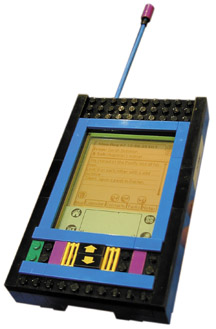
Today I heard that the Palm OS 5.0 will be the OS that supports the ARM processor. Also promised were more screen sizes and shapes.
There is also a possibility of pixel multiplying to support old applications; in other words, if they double the resolution of the screen,
what is currently a single pixel will be represented by four pixels. Whether an LCD of 320x320 will be practial at these sizes remains to be seen.
What was impressive is the amount of early preparation Palm is providing to developers to make them ready for such a radical
processor and OS shift. 2002 should be interesting.
Meet Daphne, perhaps the coolest Palm VII in the world. She's dressed up in her finest Lego attire, thanks to her clothing designer,
Tijer Tsou, a member of the ThinAirApps team. They were demonstrating their software on Daphne at PalmSource and she did her job of
catching my eye. All parts are genuine Lego, and all buttons work. The antenna even retracts. Tijer has a
website to show off his
creation. To see more about ThinAirApps: www.thinairapps.com
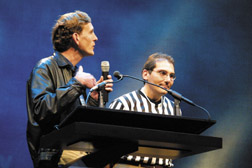
Among the PalmSource evening festivities was the game "Who wants to be a Palm OS Engineer?" Above, contestant Neil Rhodes, author
of "Palm Programming: the Developer's Guide" asks a question to stump Palm's experts below: Jim Schram, Jesse Donaldson, Steve Lemke,
Roger Flores, and Bob Ebert. Maurice Sharp was MC or referee of the game, as indicated by his striped shirt. Though the Palm guys were
able to use the Palm Knowledge base, they were most often stumped by the clever developers. 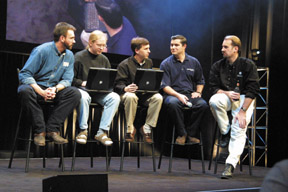
Friday, December 15, 2000
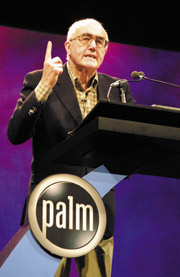
Early this morning, we were given a pipe cleaner, a newspaper, a rubber band, and a toothpick and told to make something with it. It was
part of their creativity demonstration, showing the audience what can be done with a little imagination. I made a funky fan, with tendrils to
scare away bugs, though the auditorium was nice enough that I didn't need either. Oh well. A product without a market. Others made hats and other
bizzare items.
The compelling James Burke lent his wisdom to the last Keynote, suggesting that attendees had an opportunity to change the world.
Many other speakers had said much the same thing all week, but James Burke has that signature delivery and intonation that makes you take notice.

These little mockups of future SD peripherals for an upcoming Palm device were floating around at PalmSource to tantalize all
our gadgety desires.  My impression is that they're definitely cool, but I'm concerned that they may be too small and easily lost.
But they're coming,
and Palm will finally have an expansion slot of its own. I also had a good time chatting with the Palm lab guys about future stuff.

They didn't reveal a lot, of course, since my red "Press" conference badge acted like a rectangular stop sign wherever I went, but it was
still cool to talk to the people who make this stuff happen. I like to talk tech more than I like to talk marketing.
Ripped off. I was informed this afternoon, rather rudely by a Santa Clara Convention Center staff member, that the showroom
was already shut down, the last night having been Thursday. Turkeys. I didn't see it posted anywhere, nor was it in the program.
I'm frustrated, because I spent quality time with only a few of the vendors, hoping to finish up the rest of the relatively large floor today.
Live and learn, and stop talking so much.
Future shows should have two things: a big board for quick session identification in case you lose the one they give you, and
an open showroom, where more than developers and reporters can go. It's time for Palm Source to become PalmDEX, where consumers can come, and
all vendors can display their wares. The World of Palm OS has grown big enough to support such a show, and the Palm Economy cries out for it.
Overall, it was a very good show, with good people and great stuff. Though the Palm community is indeed in danger of getting choked by
success and a corporate feel, it's at these shows when you see it's all just a bunch of people who want to make cool products that they
themselves will use, as well as make a living on. I hope that sense of community continues for years to come.
-Shawn Barnett
|

